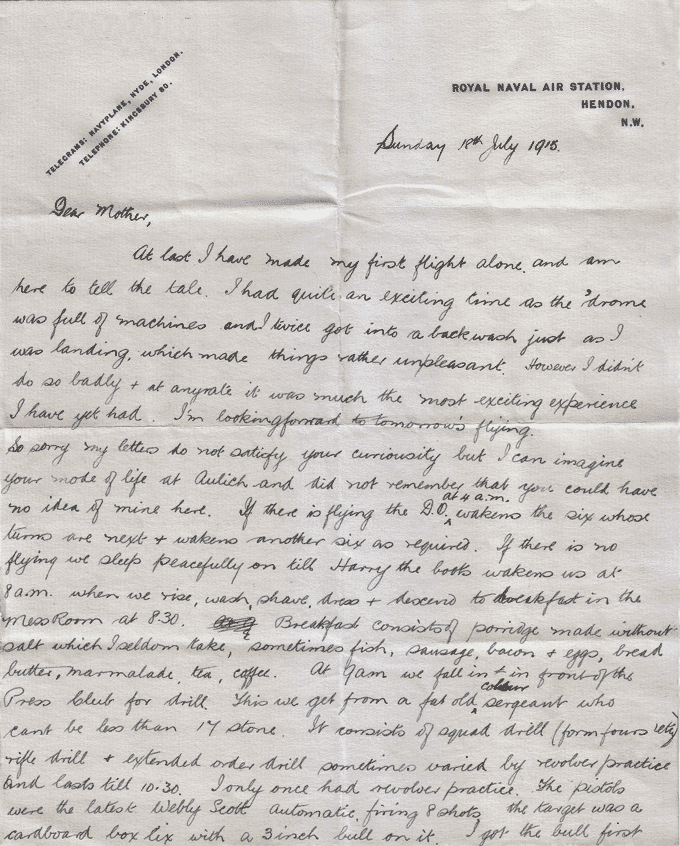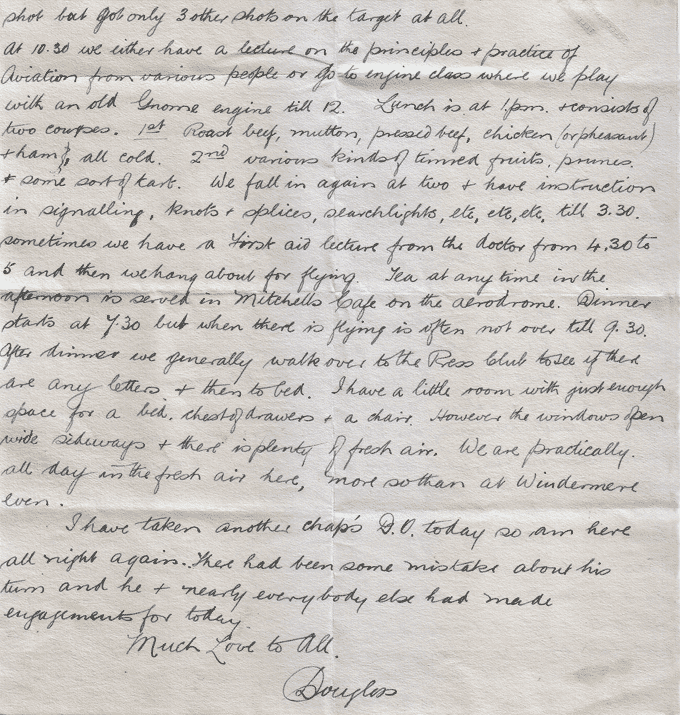Source 2: A typical training day, Hendon, July 1915
Douglas Hume joined the Royal Naval Air Service in 1915, aged 18. He started his training as a pilot in May in the Lake District. Two months later he was stationed in Hendon, in north London, where he completed his first solo flight.
You can print an image and transcript of page 1 as a Word document (Rich Text Format, 1.54MB, new window).
You can print an image and transcript of page 2 as a Word document (Rich Text Format, 1.34MB, new window).
View the timeline for an outline of John Douglas Hume's life.
|
Transcript page 1
Royal Naval Air Station
Hendon N.W.
Sunday, 18 July 1915
Dear Mother
At last I have made my first flight alone and am
here to tell the tale. I had quite an exciting time as the [aero]drome
was full of machines and I twice got into a backwash just as I
was landing, which made things rather unpleasant. However I didn’t
do so badly & at any rate it was much the most exciting experience
I have had yet. I’m looking forward to tomorrow’s flying.
So sorry my letters do not satisfy your curiosity but I can imagine
your mode of life at Aulich [a village in Perthshire] and did not remember that you could have
no idea of mine here. If there is flying the D.O. [Duty Officer] at 4am wakens the six whose
turns are next & wakens another six as required. If there is no
flying we sleep peacefully on till ‘Harry the boots’ wakens us at
8am when we rise, wash, shave, dress & descend to breakfast in the
Mess Room at 8.30. Breakfast consists of porridge made without
salt which I seldom take, sometimes fish, sausage, bacon and eggs, bread,
butter, marmalade, tea, coffee. At 9am we fall in, in front of the
Press Club for drill. This we get from a fat old colour sergeant who
can’t be less than 17 stone. It consists of squad drill (form fours etc)
rifle drill & extended order drill sometimes varied by revolver practice
and lasts till 10.30. I only once had revolver practice. The pistols
were the latest Webley Scott Automatic, firing 8 shots, the target was a
cardboard box lid with a 3 inch bull on it. I got the bull first...
(National Records of Scotland reference GD486/54)
|
Transcript page 2
... shot but only got 3 other shots on the target at all.
At 10.30 we either have a lecture on the principles & practice of
Aviation from various people or go to engine class where we play
with an old Gnome engine till 12. Lunch is at 1pm & consists of
two courses - 1st roast beef, mutton, pressed beef, chicken (or pheasant)
and ham, all cold. 2nd various kinds of tinned fruits, prunes
& some sort of tart. We fall in again at two & have instruction
in signalling, knots & splices, searchlights, etc. etc. etc. till 3.30.
Sometimes we have a First Aid lecture from the doctor from 4.30 to
5 and then we hang about for flying. Tea at any time in the
afternoon is served in Mitchell’s Café on the Aerodrome. Dinner
starts at 7.30 but when there is flying, is often not over till 9.30.
After dinner we generally walk over to the Press Club to see if there
are any letters & then to bed. I have a little room with just enough
space for a bed, chest of drawers & a chair. However the windows open
wide sideways & there is plenty of fresh air. We are practically
all day in the fresh air here, more so than at Windermere
even.
I have taken another chap's D[uty].O[ffice?]. today so am here
all night again. There had been some mistakes about his
turn and he & nearly everybody else had made
engagements for today.
Much love to all
Douglas
(National Records of Scotland reference GD486/54)
|

